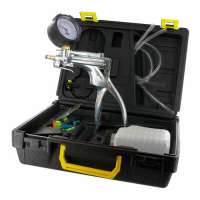FORZA HALF LITER BRAKE BLEEDER
The half-liter brake bleeder is an essential tool for any professional looking to perform efficient maintenance of the hydraulic brake system.
This device consists of a vacuum gun with a 1/2 liter bottle, equipped with an overflow valve that prevents spills and guarantees a clean and controlled bleeding process.
In addition, it has a universal rubber connector, making it compatible with a wide variety of vehicles, ensuring a perfect fit in the brake system.
The gun uses compressed air to generate a deep suction, allowing complete evacuation of brake fluid and air trapped in the system, which is crucial to maintaining brake effectiveness and safety.
For greater convenience, it includes a hook that allows you to hang the bottle while working, facilitating its use in different positions and work spaces.
Recommendations for use:
Be sure to use clean, dry compressed air to avoid contamination in the brake system.
Before starting, check that all connections are properly sealed to prevent air leaks.
Keep the bottle upright during the bleeding process to ensure maximum aspiration efficiency.
Wear gloves and protective glasses to avoid contact with brake fluid, which is corrosive.
After using the bleeder, clean all parts of the device to avoid brake fluid residue that could damage the components.
Maintenance recommendations:
Clean the bottle and vacuum gun with mild soap and water after each use to prevent residue buildup.
Periodically check the gaskets and rubber connector to ensure they show no signs of wear or damage.
Store the bleeder in a dry location protected from direct sunlight to prolong its life.
This device consists of a vacuum gun with a 1/2 liter bottle, equipped with an overflow valve that prevents spills and guarantees a clean and controlled bleeding process.
In addition, it has a universal rubber connector, making it compatible with a wide variety of vehicles, ensuring a perfect fit in the brake system.
The gun uses compressed air to generate a deep suction, allowing complete evacuation of brake fluid and air trapped in the system, which is crucial to maintaining brake effectiveness and safety.
For greater convenience, it includes a hook that allows you to hang the bottle while working, facilitating its use in different positions and work spaces.
Recommendations for use:
Be sure to use clean, dry compressed air to avoid contamination in the brake system.
Before starting, check that all connections are properly sealed to prevent air leaks.
Keep the bottle upright during the bleeding process to ensure maximum aspiration efficiency.
Wear gloves and protective glasses to avoid contact with brake fluid, which is corrosive.
After using the bleeder, clean all parts of the device to avoid brake fluid residue that could damage the components.
Maintenance recommendations:
Clean the bottle and vacuum gun with mild soap and water after each use to prevent residue buildup.
Periodically check the gaskets and rubber connector to ensure they show no signs of wear or damage.
Store the bleeder in a dry location protected from direct sunlight to prolong its life.
Bullet points
- Efficiency in the bleeding process: The use of compressed air to generate vacuum ensures that brake fluid and trapped air are evacuated quickly, significantly reducing work time.
- Universal Compatibility: The universal rubber connector allows the bleeder to be used on a wide range of vehicles, eliminating the need for additional adapters.
- Improved vehicle safety: By ensuring an air-free braking system, braking effectiveness is maximized, reducing the risk of accidents.
- Saving time and effort: The rapid evacuation of liquid and air trapped in the system makes the maintenance process more agile, allowing the user to dedicate themselves to other tasks.
FORZA HALF LITER BRAKE BLEEDER reference list
| Ref. | Weight | Price | Bottle | Capacity | Ability | Hose | Hose dimension | Sparepart | Accessories | Buy |
|---|---|---|---|---|---|---|---|---|---|---|
| H6100 | 1.2Kg | 152,40 € | 0,5l | 0,5l | 0,5l | 500mm | 500mm |  |






















































































































































































